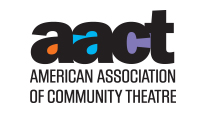Theatre Terms
 As a service to the theatre community, AACT provides over 1000 definitions of theatrical terms. Fully searchable, our glossary is helpful for technical staff, directors, actors, producers, or anyone wanting to better understand the inner workings of theatre.
As a service to the theatre community, AACT provides over 1000 definitions of theatrical terms. Fully searchable, our glossary is helpful for technical staff, directors, actors, producers, or anyone wanting to better understand the inner workings of theatre.
HOW TO SEARCH:
Click on a letter (A-Z) below to find terms beginning with the specified letter, OR enter a word in "Search for Term" OR search by entering a word in "Words in Definition." For example, entering the word "curtain" would display all words whose definition includes that word. (Note: If the A-Z or word search has been activated, it must be reset before using "Search for Term" or "Words in Definition." To reset the A-Z search: Click Here)
| Term | Definition | Link |
|---|---|---|
| ELEVATION | A working drawing usually drawn to scale, showing a view of a set or lighting rig. In general, the term "elevation" refers to a Front elevation. A Rear elevation shows backs of scenic elements. A side view of a set is known as a "section". | |
| ELEVATOR STAGE | A type of mechanized stage which has sections that can be raised or lowered. | |
| ELIZABETHAN THEATRE | English drama of the period when Elizabeth I occupied the British throne (1558-1603), although these dates are elastic. For example, the closing of the theatres in 1642 is sometimes included in an overview of Elizabethan theatre. | |
| ELLIPSOIDAL | Sometimes referred to as a Leko. Ellipsoidal Reflector Spotlights (ER Spotlights) are probably one of the most commonly used lighting instruments today. ER Spotlights typically feature a long light throw which creates a circular pool of light on the stage. These traits make the ER Spotlight ideal for lighting the stage from a catwalk There are two lenses in each ER Spotlight. Both lenses are permanently welded into place. The configuration of an ER Spotlight (6x6, 6x9, 6x12, etc.) is determined by how far apart the two lenses are from one another. Each lens is thick and curved. The lens is manufactured this way in order to resist cracking under the intense heat from the lamp. The curved lens also helps the heat to effectively dissipate. | |
| EMCEE |
For "M.C."--short for Master of Ceremonies. |
Master of Ceremonies |
| ENACT | To perform, to act. | |
| ENCORE | A call by an audience--by shouting or applause--for the reappearance of performers in order to repeat a portion of a musical or dance number. Also, to call out this word ("Encore!"). The word is French, meaning "again." | |
| ENGAGEMENT | 1) An actor's period of employment in a part. 2) An arrangement for a company to play in a theatre for a specified period of time. | |
| ENSEMBLE | 1. A cast of characters, except for the principals. 2) The grouping of the whole stage picture, involving actors and set. 3) The chorus in a musical, sometimes including soloists. 4) Said of acting or a cast in which group interaction and support is more important than individual performances. | |
| ENTER | To come onstage. Also a stage direction, as in "Ted enters from the side door." | |
| ENTR'ACTE | 1) Orchestral music played as intermission ends and a musical or opera is about begin a new act. 2) Sometimes used to mean the intermission itself. 3) In some cases, an entr'acte (meaning in French, "between acts") was a brief entertainment provided during the intermission. | |
| ENTRANCE | 1) A door or other access to the stage, for actors. 2) The act of walking onto the stage in view of the audience, as in "make an entrance." | |
| EPILOGUE or EPILOG | A scene or speech following the end of the main action of a play. In many works, the epilogue explains what happens 'afterward' to the characters. | |
| EQUALIZATION | The process of adjusting the tonal quality of a sound. A graphic equalizer provides adjustment for a wide range of frequency bands, and is normally inserted in the signal path after the mixing desk, before the amplifier. | |
| EQUITY | Actor's Equity Association, founded in 1913, is the labor union representing actors and stage managers in the legitimate theatre in the United States. | |
| ESTA | Entertainment Services and Technology Association | |
| ESTABLISH | In playwriting or production, to make clear to an audience such matters as locale, character, etc. Thus, "The playwright establishes within the first few moments that this is pre-Nazi Germany, mostly by the references to the Weimar Republic and its inflationary terrors." | |
| EXEUNT | Archaic term, meaning the exit of more than one character at the same time. | |
| EXIT | 1) Leaving the stage, to go offstage. Thus, "exit speech" and "make an exit." 2) A door or other opening through which an actor can leave the stage. | |
| EXIT LINE | A line of dialogue spoken by an actor just before, or just as, he/she leaves the stage. |




